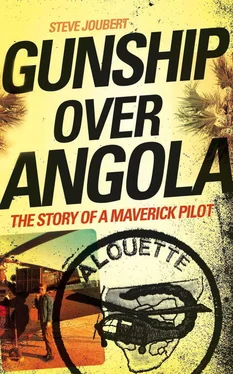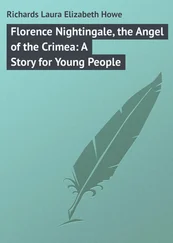Cuamato was a pretty place, with nice trees, a good supply of potable water and a number of buildings that were still usable. This was why the SADF regularly chose it as the forward staging post for short-duration raids on PLAN camps in southern Angola.
At roughly 14h00 on that first day, and about three kilometres north of Cuamato, a patrol of 20 or so SADF soldiers who had been tasked with reconnoitring the area to the north of the village walked unexpectedly into a well-defended FAPLA camp containing a few hundred soldiers. The FAPLA contingent opened fire on the patrol with anti-aircraft weapons and killed two of our infantrymen.
The two Pauls immediately got airborne to offer air support to the troops trapped on the ground. They were soon joined by two more gunships that had been sent to the scene. The two Pauls were operating below a sizeable cloud of smoke and exploding anti-aircraft projectiles but were seemingly unaware of the intensity of the FAPLA reaction to their presence.
At dusk, when the infantrymen who’d been trapped since the start of the contact were finally able to withdraw, the two Pauls and the other two gunships returned to overnight at Ombalantu, which was situated just inside South West Africa. There, they were joined by another four gunships and a .303-equipped Alo III trooper (able to carry a crew of two and a maximum of three passengers), which would carry the battle commander in the following day’s ops and would be flown by me. That night, in the Ombalantu pub, we heard how, as they neared Cuamato in the fading light of the late afternoon, it had looked like a scene from a war film.
Early the next morning, the nine Alos left Ombalantu and arrived at Cuamato just before sunrise. A quick local intelligence update informed us that during the night there had been a lot of vehicle movement from the direction of the FAPLA positions. Based on past experience, it was likely that FAPLA had used the night hours to pull back rather than risk any further confrontation with the SADF.
Our formation of eight gunships and my trooper got airborne just as the sun peeked over the easterly horizon, and we headed at treetop height for the original PLAN base target around 25 kilometres away. As we approached just to the east of the FAPLA positions that had caused so many problems the previous day, our formation leader, Lieutenant Billy Port, began describing to the five of us who’d not been there the day before exactly where the FAPLA camp was located.
The radio call went something like this: ‘Okay, okes, you see the fence of dried bushes coming up – that is the southern border of the camp. The northern border is where the thick bush starts and the headquarters is where—’
He didn’t finish the sentence.
Without warning, a whole barrage of FAPLA weaponry opened fire on us from dug-in positions along a 200-metre-long line of trenches and camouflaged structures, situated roughly in the middle of the FAPLA camp. One moment there was nothing happening, and the next it was as if a massive warehouse filled with fireworks had spontaneously ignited.
Fortunately, we were already as close to the ground as it was possible to get and so were able to dodge the barrage. Immediately, the plan to attack the original PLAN objective was put on ice and we spent the rest of the morning, supported by ground-attack Mirages and Impalas, in subduing the FAPLA base.
In the afternoon, as the overrun FAPLA base was being swept by our ground troops, I flew well-known war correspondent and photographer Al J Venter around the area to get an idea of the scale, orientation and layout of the battlefield. He later used photographs taken that day in his book The Chopper Boys .
After I dropped him off at Cuamato, I took two brigadiers, one of whom was Bossie Huyser, the SAAF commanding officer in South West Africa, to the FAPLA camp. After switching off the engine, the flight engineer disappeared into the maze of trenches to look for an AK-47 for personal use. (All combat aircrew could choose what weapons they wanted to include in their on-board survival equipment, and the AK-47 was a preferred choice. It could always be relied on to fire when needed, irrespective of any abuse it might have suffered. We had all seen videos of an AK-47 that had been immersed in mud for six months being lifted out of the corrosive goo and immediately cocked and fired.)
I attached myself to the two brigs but had the (in my case) rare foresight to carry my own AK-47 with twin magazines taped together while we strolled along inspecting the overrun FAPLA camp. About ten metres in front of us, a young sapper carrying a metal detector was preparing to negotiate the steep entrance to one of the many underground bunkers when, from within the bunker, a FAPLA soldier who was hiding there shot him. The force of the AK-47 bullet lifted the sapper clean off his feet and catapulted him backwards as if he’d been snatched by a giant invisible hand.
We rushed forward and pulled the seriously wounded young man out of harm’s way. The area around us suddenly bristled with activity as soldiers emptied entire magazines into any bunker entrance they could find.
Twenty metres away, the commander of the ground troops, a Major Blaauw, shouted forcefully, ‘Make sure that all the bunkers are clean!’ before he dashed forward, pulled the safety pin from a fragmentation grenade and tossed it into a bunker in front of him.
He was standing in front of the entrance to the bunker when the grenade exploded inside with a muffled thump. A huge tongue of flame blasted out of the entrance and completely engulfed him, searing any exposed flesh and melting the hair on his head so that it resembled a shiny skullcap.
Without hesitation, I turned and headed at breakneck speed for my Alo. My mind was in a frantic whirl, but then time seemed to slow, as it did when the screws were on. I shouted loudly for medical personnel to attend to the casualties and to bring them to the chopper as soon as they could be moved so that I could fly them both to Cuamato. From there, the Pumas could get them to expert medical care at Oshakati or Ondangwa.
Then I yelled for my engineer, Theo Munroe, to get the hell out of whatever trenches he was in and get back to the Alo III trooper. Lastly, I called for the two brigadiers to stay put at the LZ, as I would return to collect them after I’d done the casualty evacuation. Before long, both the major and the sapper were bundled aboard and we took off for Cuamato, barely three kilometres away.
The indelible memory that I have of that two-minute flight is of Major Blaauw, clearly in a state of shock, rubbing the top of his skull where the charred blob of molten goo that had been his hair had adhered. This action caused the blob to break apart into small pieces that floated all around the cockpit. A piece found its way into one of my nostrils and I still shudder and retch when I recall the unbelievably acrid odour.
I spent another night at Ombalantu, during which I swapped the trooper for a gunship from one of the Alo pilots who was going home. Before dawn, our formation of eight gunships returned to Cuamato, all of us absolutely certain that the FAPLA force, or any survivors of the previous afternoon’s sweep, would have left the scene during the night. They’d taken an awful pounding and would likely want to get as far away from the SADF as possible.
We still intended to hit the original PLAN target that morning.
But, just as the Alo formation came in to land at Cuamato, one behind the other, the two lead aircraft peeled off and started to climb up to their operating height of 800 feet (250 metres). They had been instructed to provide top cover for a couple of Pumas that were about to uplift a 20-strong group of our troops who had been lying in ambush throughout the night next to the road leading from the FAPLA camp to Cuamato.
Читать дальше












